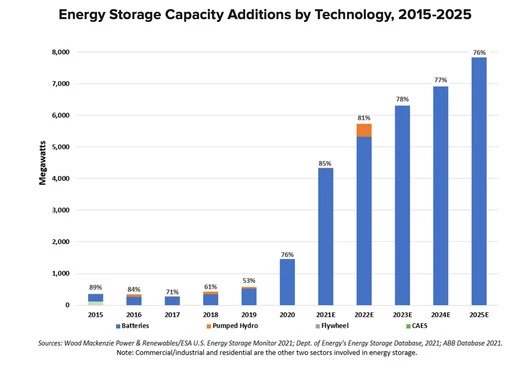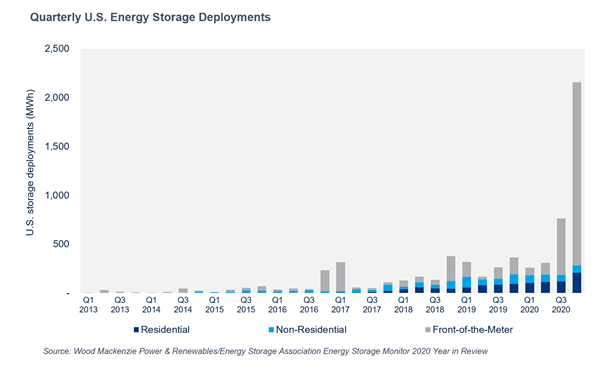Microgrids are the Next Big Thing
Technology never stops evolving, never stops improving. Microgrid technology has seen one of the largest booms in recent years as their benefits are proving to be harder to ignore. Microgrids continue to be a great option for consumers to increase their autonomy, stability, and reliability. As the climate changes and more extreme weather events become more common, the reliability of the grid is in jeopardy; fortunately, the most recent advancements in energy storage add a layer of support to the grid and provide another battery solution for microgrids. Electric companies have already set their sights on energy storage technology and made moves to integrate it into their grids. Simultaneously, independent microgrid consumers will be happy to reap the rewards too.
A technology integral to a microgrid’s performance is the battery. Batteries and other forms of energy storage have become a necessary part of energy generation installations. A good battery or energy storage system provides autonomy to the grid it serves by allowing the operator to store energy it does not need at the moment and use it later when it is needed. In the past year energy storage installation grew 200%. Just in the fourth quarter of 2020 alone 2,156 MWh of energy storage was brought online, which was at least 182% more than the third quarter of the same year. As prices for energy storage fall and individual battery capacity increase, energy storage installations have seen steady growth as you can see in the graph below:
The largest share of this recent energy storage is represented by battery technology. In fact, the nearly 1500 MW of energy storage capacity that was brought online last year was battery technology. Deployments and installations of battery energy storage are estimated to increase drastically over the next 5 years as shown in the graph below:

As such, battery technology will need to continue to improve capacity and, more importantly, the duration of charge in order to remain a viable option for microgrids. Currently the battery most commonly used in microgrid energy storage is lithium-ion, but that might not last. Long-Duration Energy Storage has achieved great progress over the past several years – these innovative solutions employ different methods to improve its duration of charge and a few of the more common and prominent methods are listed below.
- Iron-Air batteries – uses iron and electrochemistry to make reversible rust iron
- Gravity-Based storage – uses water pumps to create potential energy in an elevated large rock mass (water towers use this method)
- Hot-rock thermal storage – heats up tiny stones in steel tanks and releases the stored energy through a turbine for electricity
Climate change has decreased the reliability of utility-sized grids in recent years with polar vortices and equally extreme heat waves in places that normally would not experience these challenges. Long-duration solutions will allow grids to buffer against extreme weather patterns, provide energy wherever and whenever it is needed, and reduce costs for grid-operators. It allows operators to employ load shifting, where they store energy when there is excess supply and then deploy it when there is more demand. Lithium-ion batteries have been, and continue to be, a great solution for storing and discharging energy, especially with renewable energy sources. However, these new energy storage instruments have a leg up on the lithium-ion batteries as they have a better degradation pattern while keeping all the benefits of lithium-ion. Furthermore, these long-duration energy storage systems help avoid costs in utility-sized renewable energy grids.
Lately, electric companies have been the leaders in energy storage deployment. 70% of the battery energy storage capacity that has been deployed over the last five years has been by the electric companies. This technology will help improve these companies’ ability to increase grid reliability and offer their customers better energy services. It also helps reduce operating costs and in turn, pass on savings to the customers or repurpose those savings for future investments in grid resilience. Energy storage brings multiple benefits to utilities and creates a virtuous cycle that will drive further installations down the road.
Even more support has come from the Department of Energy in July when Energy Secretary Granholm announced the government’s new goal of reducing the cost of these energy storage solutions by 90% over the next decade. Cheaper systems mean more accessible systems and subsequently more deployment. With higher deployment, more microgrids can utilize renewable energy. Furthermore, trade organizations are lobbying hard to get them included as an eligible technology for the federal ITC (Investment Tax Credit). If they are successful, it would subsidize the purchases of these long-duration energy storage devices for consumers and installers, encouraging them to include these devices in their own microgrids and energy storage projects. This technology is a good indication that Biden’s plan for clean electricity by 2035 is well within reach and carries hopes that it will create more jobs and increase the use of renewable technologies.
Interest coming from the Department of Energy, utilities, and energy venture capitalists demonstrates the eagerness to get this technology to a stage of commercialization. In the past month at least five of the leading producers of long-duration energy storage solutions have received millions in funding. In fact, a Minnesota utility co-op, Great River Energy, has announced that they are starting a long-duration energy storage pilot project with Form Energy to introduce their Iron-Air batteries to the Minnesota energy grid. Great River Energy is looking to achieve 50% energy generation from renewable sources by 2030 and sought Form Energy’s battery to help reach that goal. With the backing of a utility cooperative, this pilot project proves that this technology will be a great alternative to the commonly found lithium-ion energy storage options in microgrids.
These advancements and investments into the energy storage industry positions the microgrid industry and its consumers to be the big winners. The autonomy, stability, reliability, flexibility, scalability, and efficiency that microgrids provide are all improved with the introduction of long-duration energy storage solutions. Microgrids and their related technologies are continually evolving and becoming a necessity for a clean and sustainable energy future. Paired with other innovative solutions, the energy grid as we know it today can be completely transformed in the future.

